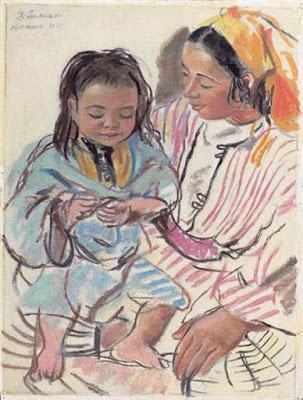
Mother and Daughter by Zinaida Serebriakova
- The self-giving care
- The person cared for
- The universe upholding those cared for
perform action which should be done (your duty). For, by
performing action without attachment man reaches the supreme.Especially for my eldest daughter, Josie, I am not attached to her taking care of me in return one day. Likely, because I do not depend on the eldest to care for me one day, I also do not expect any of my children to care for me. Perhaps this is from losing my mother at sixteen and not seeing filial piety in action for elder care. I’ll be grateful for whatever (if anything) is offered later in life, but the expectation is not currently planted in my future. I also do not expect my children to fulfill my dreams for me. I wanted each of them, fiercely, and my sole intentions for them are to assist their journeys as long as they need me.I am aligned with the giving of care. I am aligned with the giving of compassion. My intention is ahimsa (non-harm). When I occasionally rage inside or host a bit of an inner rebellion, I try to go on a long walk, car ride, or hike in the woods. The muck—the fear, the stress, the cascading blood pressure, stifled breath—all arise in the caregiving day. Caregiving for a loved one, young or old, especially those with significant and complex medical conditions, one often sits with fear of loss, each day, often for several instances and moments. During this pandemic fear greets me frequently when I sit on and off of my yoga mat. I do not know if my eldest daughter will survive if she falls ill from COVID-19. She’s had three hospitalizations for viral-induced pneumonias in her fourteen years of life, and I do not know how she will process COVID-19. I also do not know how my son’s severe asthma will show up with COVID-19. I myself have asthma and psoriatic arthritis, so my own health and interaction with this pandemic world does not feel optimum.When I feel anxious or unsettled, active asana practice moves the energy a bit, tries to ground anxiety into steadier roots, and sometimes removes stuck-ness, like unclogging a drain, getting gears moving the machine of body, mind, spirit, reconnecting those train cars and have ‘em greasing rails again. I like gentle and loving sequences, such as these:
- Tadasana (Mountain pose), coming into Utkatasana (Chair pose), and then sometimes wiggling and shifting into Malasana (Garland pose)
- Marjaryasana (Cat), Bitilasana (Cow), and then Balasana (Child’s pose)
- Listening to my breath.
- Feeling my breath move into my nostrils, mouth, and parts of my chest.
- Asking if my breath is going deeper into my back lungs or feeling shallower, caught in this feeling like I can’t complete a yawn (this is always a source of stress or pause for me).
- I breathe deep into the back lungs/rib areas.
- I lift up my arms and side bend over to the opposite side, then breathe into the lung tissue under the armpit, taking turns on each side.
- I sit or stand against a wall, close my eyes, and try to breathe, feeling supported and safe against the sturdiness of the wall and calmer with less sensory stimulation to my eyes.
- I extend my exhalation, making my exhalation twice as long as my inhalation by breathing in for, say, a count of 3, then exhaling for, say, a count of 6. Then I gradually lengthen my exhalation even more in the hopes of slowing any racing-ness of my heart from stress.
 Sarah Blunkosky, M.A., 200 E-RYT, RYT 500, RPYT, RCYT is an integrative education consultant, certified peer-breastfeeding counselor, and registered Accessible Yoga instructor specializing in family, children’s, special-needs, and prenatal/postpartum movement/embodiment. Her learning life spanned teaching high school social studies at Open High School in Richmond, Virginia to studying slavery and social history on a graduate school path that pivoted when her eldest daughter's intellectual disabilities and medical needs required an intensive lifestyle shift. She started Learning Heroine LLC in 2015. You can find her on Instagram and Facebook sharing her dharma/mission: Set learning free. When she isn’t homeschooling her kids or teaching yoga, you can find her writing articles and working on a book. A forever student of yoga, she is also studying to become a certified yoga therapist. Subscribe to Yoga for Healthy Aging by Email ° Follow Yoga for Healthy Aging on Facebook ° To order Yoga for Healthy Aging: A Guide to Lifelong Well-Being, go to Amazon, Shambhala, Indie Bound or your local bookstore.
Sarah Blunkosky, M.A., 200 E-RYT, RYT 500, RPYT, RCYT is an integrative education consultant, certified peer-breastfeeding counselor, and registered Accessible Yoga instructor specializing in family, children’s, special-needs, and prenatal/postpartum movement/embodiment. Her learning life spanned teaching high school social studies at Open High School in Richmond, Virginia to studying slavery and social history on a graduate school path that pivoted when her eldest daughter's intellectual disabilities and medical needs required an intensive lifestyle shift. She started Learning Heroine LLC in 2015. You can find her on Instagram and Facebook sharing her dharma/mission: Set learning free. When she isn’t homeschooling her kids or teaching yoga, you can find her writing articles and working on a book. A forever student of yoga, she is also studying to become a certified yoga therapist. Subscribe to Yoga for Healthy Aging by Email ° Follow Yoga for Healthy Aging on Facebook ° To order Yoga for Healthy Aging: A Guide to Lifelong Well-Being, go to Amazon, Shambhala, Indie Bound or your local bookstore.

